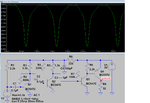sgreen
Junior Member level 3
Currently I am working with a circuit that captures audio signal by using a microphone. It gives the amplified output through speaker or headphone. After that I need only analog part that ranges from 1.5-2V (continuously varying). But in the output ac and dc both term are present. DC voltage ranges 2.9-3V.For removing DC Part I am using 10uf electrolytic capacitor between amplified output and target. But it doesn't work. The target is microcontroller ADC input for sampling. As it contains dc it creates a problem. Amplifier circuitView attachment microphone_ckt.bmp is given here. Please help me in this regard.
